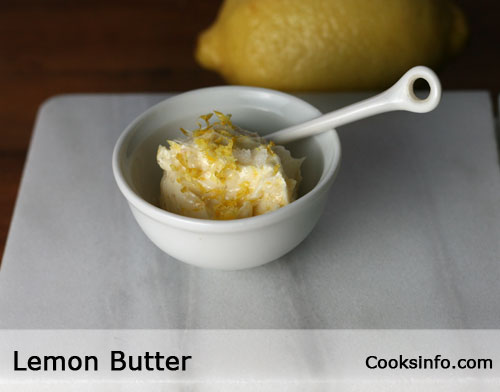
© Randal Oulton
Lemon Butter is butter blended with lemon zest, salt and pepper. It has just a light, subtle, aromatic taste of lemon.
In classical French cooking, it is used as a garnish for cold hors d’oeuvres.
It’s also good on hot foods where a small, flavourful dollop melts like a sauce. Try it on “meats” such as on steak, fish, seafood or chicken; or on hot vegetables such as Brussel sprouts, broccoli or green beans.
It’s a very simple way to do something special for guests when you are pressed for a lot of prep time.
“Lemon Butter” recipes that call for sugar and eggs are actually a North American name for Lemon Curd; see separate entry for Lemon Curd.
Cooking Tips
Classic Proportions: 200 g (7 oz / 1 cup minus 2 tbsp) softened unsalted butter; the zest of 1 washed lemon. Salt and pepper to taste.
To make a smaller amount try: 50 g (4 tablespoons) of softened unsalted butter, zest of ¼ a washed lemon, salt and pepper to taste.
The pepper used can be white or black pepper, but white has two advantages: the “wine-y” taste of the white doesn’t fight with the light lemon taste, and white pepper doesn’t look like fly specks in the butter.
Very nice when made with a few pinches of crunchy, granular salt such as Maldon salt that adds texture. In any event, you’ll want to avoid an iodized salt.
Note that there is no lemon juice in the version defined by Larousse Gastronomique; only lemon zest. Consequently, it’s best made at least 4 to 8 or more hours in advance so that the subtle perfume and oil from the lemon zest has time to permeate the butter.
Nutrition
You only need a teaspoon of this as it packs a load of flavour. But to lighten the concept up, try just a wedge of lemon to squeeze over foods on its own instead of the butter.
You can use a salt substitute. Or, if you are using salted butter, additional salt may not be needed at all.

